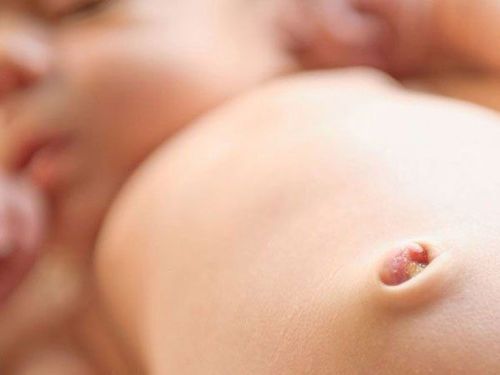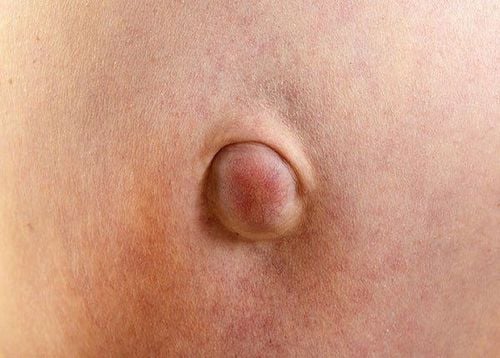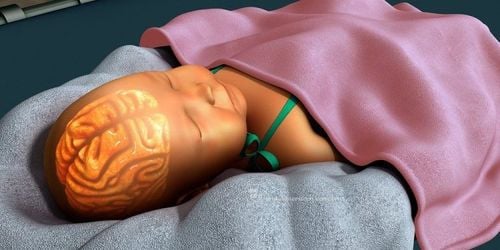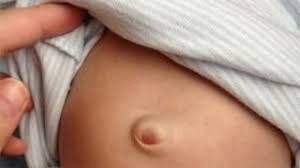This is an automatically translated article.
The article is expertly consulted by Master, Doctor Phan Thi Cam Van - Department of Pediatrics - Neonatology - Vinmec International General Hospital Da Nang. He has 7 years of experience as a Resident Doctor and a Pediatrician - Neonatal Doctor at Hue Central Hospital and Hue University Hospital of Medicine and Pharmacy. Her strengths are in newborn care and treatment, neonatal resuscitation: respiratory diseases, digestive diseases, feeding, common newborn problems.Umbilical hernias are common malformations in young children, especially infants and girls. Early identification of symptoms will help children avoid dangerous complications.
1. What is an umbilical hernia?
Umbilical hernia occurs when an organ or a part of an internal organ protrudes out of its normal position in the body, when the abdominal organs protrude out, forming a protrusion in the navel area. The hernia may contain fluid, an internal organ such as the intestine, or other organs from the abdomen.2. Causes of umbilical hernia in children
The umbilical cord carries nutrients to the baby while in the womb. The umbilical cord enters the body through a small opening in the abdominal wall muscle and is cut after the baby is born.Within 1-2 weeks after birth, the umbilical cord gradually atrophies and falls off, the wound heals and forms the baby's navel. As your baby grows, the hole in the abdominal wall where the umbilical cord passes will automatically close. An umbilical hernia occurs when the abdominal muscles do not close properly.

Thoát vị rốn ở trẻ xảy ra khi các cơ bụng đóng không kín
3. Signs of umbilical hernia
A round mass emerges right at the navel. You can see this bump and feel it when you press it very gently on the navel area. The hernia can enlarge when the baby cries, coughs, stretches to have a bowel movement, or when the baby sits up. This mass may get smaller or disappear as your baby relaxes. Umbilical hernias are usually painless.When children have an umbilical hernia, they often have symptoms such as:
Crying loudly, or showing pain The abdomen seems to be bigger, rounder, "full" than usual The skin above the hernia becomes swollen. and red Fever Vomiting Difficulty passing or not at all Having blood in stools
4. Complications of umbilical hernia in young children
Umbilical hernias in young children rarely cause complications. However, sometimes a loop of bowel can become trapped in the hernia and cannot be pushed back into the abdomen. Less blood reaches that part of the intestine, causing pain in the umbilicus and damage to intestinal tissue.More seriously, the intestine can be blocked, completely not receiving blood, leading to gangrene. Infection can be disseminated intra-abdominal, life-threatening.

Biến chứng của thoát vị rốn ở trẻ nhỏ
5. How to treat umbilical hernia?
Most doctors advise parents to do nothing because most cases will clear up on their own by the time the baby is 1 year old. As the baby grows, the abdominal muscles get stronger and can close the hole in the abdominal wall, the hernia will go away on its own (usually by the time the baby turns 1 year old).In some cases the hernia disappears only after 4-5 years of age. On examination, the doctor can easily push the hernia into the abdomen, but you should not try to do this.
In the past, it was suggested that using tape to stick a coin on the hernia helped speed up the healing process. Research shows that abdominal wall holes causing hernias will close by themselves as quickly as when not using adhesive tape, coins.
Medical experts recommend that it is not appropriate to use tape, coins or other pressure bandages on the umbilical hernia to make it smaller. These methods can even make the situation worse, such as causing infection or blocking blood flow to the tissue inside the hernia. Surgery is usually indicated for cases where the hernia is very large and causes pain.
As a key area of Vinmec Health system, Pediatrics Department always brings satisfaction to customers and is highly appreciated by industry experts with:
Gathering a team of top doctors and nurses in Pediatrics : consists of leading experts with high professional qualifications (professors, associate professors, doctorates, masters), experienced, worked at major hospitals such as Bach Mai, 108.. Doctors All doctors are well-trained, professional, conscientious, knowledgeable about young psychology. In addition to domestic pediatric specialists, the Department of Pediatrics also has the participation of foreign experts (Japan, Singapore, Australia, USA) who are always pioneers in applying the latest and most effective treatment regimens. . Comprehensive services: In the field of Pediatrics, Vinmec provides a series of continuous medical examination and treatment services from Newborn to Pediatric and Vaccine,... according to international standards to help parents take care of their baby's health from birth to childhood. from birth to adulthood Specialized techniques: Vinmec has successfully deployed many specialized techniques to make the treatment of difficult diseases in Pediatrics more effective: neurosurgery - skull surgery, stem cell transplantation. blood in cancer treatment. Professional care: In addition to understanding children's psychology, Vinmec also pays special attention to the children's play space, helping them to have fun and get used to the hospital's environment, cooperate in treatment, improve the efficiency of medical treatment.
Please dial HOTLINE for more information or register for an appointment HERE. Download MyVinmec app to make appointments faster and to manage your bookings easily.













